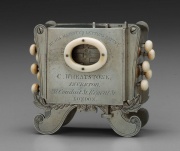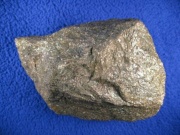Difference between revisions of "Nickel"
| Line 50: | Line 50: | ||
° Web Elements: [http://www.webelements.com/webelements/elements/text/Ni/key.html Website] | ° Web Elements: [http://www.webelements.com/webelements/elements/text/Ni/key.html Website] | ||
| − | == Authority (list of | + | == Authority (list of other sources checked for information on this subject)== |
* ''Van Nostrand's Scientific Encyclopedia'', Douglas M. Considine (ed.), Van Nostrand Reinhold, New York, 1976 Comment: date first isolated = 1751 | * ''Van Nostrand's Scientific Encyclopedia'', Douglas M. Considine (ed.), Van Nostrand Reinhold, New York, 1976 Comment: date first isolated = 1751 | ||
Revision as of 08:49, 30 October 2015
Description
A silvery-white, magnetic metallic element. Nickel occurs naturally in many ores such as nicolite, pyrrhotite, pentlandite, and garnierite as well as in metallic meteorites. Its abundance in the earth's crust is 99 ppm and large reserves are located in Ontario, Norway, Finland, Cuba, China, and Australia. Nickel was first isolated by Axel F. Cronstedt in 1751. Metallic nickel is a hard, malleable metal that can take a high polish and remain untarnished. It is most often used as a protective and ornamental electroplated coatings on other metals, such as iron and steel. Nickel is also used to produce Monel®, a highly corrosion resistant nickel-copper alloy, as well as many other alloys. In Europe, nickel is prohibited in jewelry, watches, and zippers because of its carcinogenic potential via skin absorption.
Synonyms and Related Terms
Ni; Nikkel (Ned.); nichel (It.); Níquel (Port.); niquel (Esp.); nicolite; pyrrhotite; pentlandite; garnierite
Other Properties
Slightly soluble in dilute hydrochloric and sulfuric acids. Soluble in nitric acid. Resistant to alkalis.
| Composition | Ni (atomic no. 28) |
|---|---|
| CAS | 7440-02-0 |
| Mohs Hardness | 3.8 |
| Melting Point | 1453 |
| Density | 8.908 |
| Molecular Weight | atomic wt = 58.6934 |
| Boiling Point | 2732 |
Hazards and Safety
Flammable and toxic as dust and fumes. Oxyacetylene welding may form the highly toxic nickel carbonyl gas. Metallic nickel is a carcinogen and can cause skin allergies.
LINK: International Chemical Safety Card
Additional Information
° O. Untracht, Metal Techniques for Craftsmen, Doubleday and Co., Garden City, NY, 1968. ° F. B. Howard-White, Nickel: An Historical Review New York: D. Van Nostrand Company, 1963. ° Web Elements: Website
Authority (list of other sources checked for information on this subject)
- Van Nostrand's Scientific Encyclopedia, Douglas M. Considine (ed.), Van Nostrand Reinhold, New York, 1976 Comment: date first isolated = 1751
- Random House, Webster's Encyclopedic Unabridged Dictionary of the English Language, Grammercy Book, New York, 1997
- The American Heritage Dictionary or Encarta, via Microsoft Bookshelf 98, Microsoft Corp., 1998
- Richard S. Lewis, Hawley's Condensed Chemical Dictionary, Van Nostrand Reinhold, New York, 10th ed., 1993
- The Merck Index, Martha Windholz (ed.), Merck Research Labs, Rahway NJ, 10th edition, 1983 Comment: entry 6582; date first isolated = 1754
- G.S.Brady, Materials Handbook, McGraw-Hill Book Co., New York, 1971 Comment: p. 527; date first isolated = 1751
- Dictionary of Building Preservation, Ward Bucher, ed., John Wiley & Sons, Inc., New York City, 1996
- Tom Rowland, Noel Riley, A-Z Guide to Cleaning, Conserving and Repairing Antiques, Constable and Co., Ltd., London, 1981
- Michael McCann, Artist Beware, Watson-Guptill Publications, New York City, 1979
- External source or communication Comment: Contribuiotion by Arian Sheets

